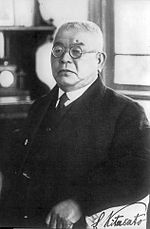Kitasato Shibasaburō facts for kids
Quick facts for kids
Kitasato Shibasaburō
|
|
|---|---|
 |
|
| Born | January 29, 1853 Oguni, Kumamoto
|
| Died | June 13, 1931 (aged 78) |
| Nationality | Japan |
| Known for | Bubonic plague |
| Scientific career | |
| Fields | Bacteriology |
| Institutions | Tokyo Imperial University |
| Influences | Robert Koch |
Baron Kitasato Shibasaburō (born January 29, 1853 – died June 13, 1931) was a Japanese doctor and bacteriologist. A bacteriologist is a scientist who studies tiny living things called bacteria.
He is famous for helping to discover the cause of the bubonic plague in Hong Kong in 1894. This happened during a serious outbreak of the disease. He found it at almost the same time as another scientist, Alexandre Yersin.
Kitasato was considered for the very first Nobel Prize in Physiology or Medicine in 1901. He and Emil von Behring worked together in Berlin in 1890. They announced they had found a way to create a treatment for diphtheria using a special serum. Von Behring won the Nobel Prize for this work, but Kitasato did not.
Contents
About Kitasato Shibasaburō
Kitasato was born in a village called Okuni, in what is now Kumamoto Prefecture, Kyūshū. He studied medicine at Kumamoto Medical School and later at Tokyo Imperial University.
Early Studies and Discoveries
From 1885 to 1891, Kitasato studied with a famous scientist named Robert Koch at the University of Berlin. In 1889, Kitasato became the first person to successfully grow the tetanus germ in a pure culture. This means he grew only the tetanus germ without other germs mixed in.
In 1890, he worked with Emil Adolf von Behring to create a special treatment for tetanus using this pure culture. They also worked on treatments for diphtheria and anthrax. Kitasato and Behring showed that their treatment could prevent diseases. They did this by giving an animal small amounts of blood serum from another animal that had the disease. This made the first animal immune, meaning it was protected from getting sick. This discovery led to a new field of medicine called serotherapy, which has helped many people around the world.
Return to Japan and New Institutes
After returning to Japan in 1891, Kitasato started the Institute for Study of Infectious Diseases. He got help from a well-known person named Fukuzawa Yukichi. Kitasato showed how dead germs could be used to create vaccinations, which help protect people from diseases. He also studied how tuberculosis spreads.
In 1894, the Japanese government asked Kitasato to go to Hong Kong. There was a big outbreak of the bubonic plague happening. Kitasato found a bacterium that he believed was causing the disease. Another scientist, Yersin, found the same germ a few days later. While there was some debate about who found it first, many scientists now agree that Kitasato did find and study the plague germ.
Four years later, Kitasato and his student Shiga Kiyoshi were able to find and describe the germ that causes dysentery, a serious stomach illness.
Later Work and Legacy
After his work on the bubonic plague, Kitasato continued to study infectious diseases. He researched epidemics in Northeast Asia and gave a presentation on tuberculosis in Europe in 1909. In 1911, he went to Manchuria to study a severe outbreak of pneumonic plague. He believed his goal was to improve public health through science.
In 1914, the Institute for Infectious Diseases became part of Tokyo Imperial University. Kitasato disagreed with this change and resigned. He then founded the Kitasato Institute (which later became Kitasato University). He led this institute for the rest of his life. He also helped create a new medical facility with Fukuzawa Yukichi, which became an important center for medical learning in Japan.
In 1921, Kitasato started a company called Sekisen Ken-onki Corporation. Their goal was to make the best possible clinical thermometers. This company later changed its name to Terumo Corporation.
Kitasato also held many important positions. He was the first dean of medicine at Keio University and the first president of the Japan Medical Association. He also served in the House of Peers, which was part of the Japanese government. In 1924, he was given the special title of danshaku, which means baron. Even though he took on more political roles, he kept working on improving our understanding of tuberculosis until he died. He made huge contributions to public health.
Kitasato Shibasaburō died on June 13, 1931, in Tokyo. He is buried at the Aoyama Cemetery in Tokyo.
His picture will be on the new 1,000 yen banknotes that will be released in 2024.
Images for kids
See also
 In Spanish: Kitasato Shibasaburō para niños
In Spanish: Kitasato Shibasaburō para niños



